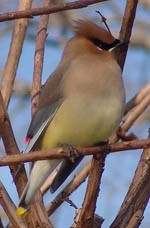Birds on the Move

Field Scientists Putting Today's Science in the Hands of Students
Recent additions to the Science Buddies library of Project Ideas utilize animal movement data from Movebank.org. Among the field scientists who worked on developing these student-accessible explorations with Science Buddies:
- Roland Kays, curator of mammals at the New York State Museum. You can follow Roland's current research and tracking of "fishers"—6-13 pound weasels— on his New York Times Science blog.
- Martin Wikelski, a zoologist and physiological ecologist at Max Planck Institute for Ornithology. Martin was named one of 2010's Adventurers of the Year by National Geographic.
Two weeks ago, I walked out to drop my kids at school, and as I pulled the door closed to lock it, the sound of birds in the backyard caught my attention. Turning to look, I saw that the tree beyond our small backyard and positioned almost between our house and the next was dripping... with robins. I don't mean there was one robin, or even two. There were dozens of robins sitting on the branches, their tawny orange glinting in the sun breaking through the canopy of leaves, and I smiled in seeing them there.
A few years ago, I did an informal, daily study of the birds in my area. For an entire year, I watched the birds. Every day, I recorded my observations, writing down what birds I saw in my neighborhood and in my daily travels, even if those travels often only involved a one- to two-mile circuit. There were many birds to observe, discover, and watch.
The robins quickly became a familiar sight that year, having arrived in the Bay Area shortly after I started actively "watching." I saw them first singly and in pairs or small clusters in other trees in my area. On the day I saw them sitting in the tree in the backyard, they were joined by cedar waxwings, a bird I'd never seen before but found amazing with its golden brown, grey, and soft yellow coloring, dark masked face, and crested head. On that day, the tree was covered with birds. It is an unusual tree on the windswept, ocean-facing hill behind my house. The branches stretch horizontally, tapering in length as they near the top. With chubby robins and sleek cedar waxwings perched on every lateral branch, the tree took on the appearance of a row boat. It was a wonderful moment in bird watching. The tree is not berry-laden, and so the waxwings that day were only passing through. They don't hang out in our backyard, but when I saw the robins there again on that "row boat" of a tree, I marveled at the consistency of migration patterns.
From Backyard to Science Project
Bird watching is a pastime for all ages, and "birders" often have a story of a friend or family member who got them interested in bird watching. Whether you live in an exotic location, or a temperate clime, or somewhere with hard seasons and long winters, one thing is certain... there are birds that probably call your area home at certain times of the year. Students interested in learning more about the science of bird migration can develop a range of observational and analysis-based science projects. Students using the Science Buddies website also have the opportunity to use Movebank.org data to allow them to study movement patterns of a range of animals and birds.
Students interested in birds, zoology, or even conservation and environmental engineering, can explore relevant issues in the following projects:
- Do Migratory Birds Like It Hot?: use Movebank.org data to explore the relationship between air temperature and where and when birds migrate. (zoology)
- Here Today, Gone Tomorrow: Saving Migratory Animals: use Movebank.org data to study the migratory path for a bird species and then devise conservation planning strategies to ensure habitats are maintained. (environmental science)
- With a Little Bread as Bait, Can You Make a Bird Migrate?: observe the impact of food shortage on migration. (zoology)
- Are We There Yet? Test How Migratory Birds Navigate: use Google Earth and data on white-crowned sparrows to track their 2,000+ mile migration. (zoology)
- Where, Oh Where, Do the Wild Wolves Wander?: analyze the gray wolf pack's territory and seasonal movement. (zoology)
- Using Animal Tracking Data from Movebank for Science Projects: with access to animal movement data, students can devise an independent project analyzing an aspect of movement or migration studies. Several volunteers in the Science Buddies Ask an Expert forums specialize in movement and migration studies, so students working on projects in this area of science may find assistance with planning and shaping a long-term independent project.
Categories:
You Might Also Enjoy These Related Posts:
- Plastics and Earth Day - Science Projects
- Arduino Science Projects and Physical Computing
- 10+ Robotics Projects with the BlueBot Kit
- 5 STEM Activities with Marshmallow Peeps
- March Madness Basketball Science Projects: Sports Science Experiments
- Women in STEM! More than 60 Scientists and Engineers for Women's History Month
- Explore Artificial Intelligence and Machine Learning with Student AI Projects
- 10 Reasons to Do the Rubber Band Car Engineering Challenge









